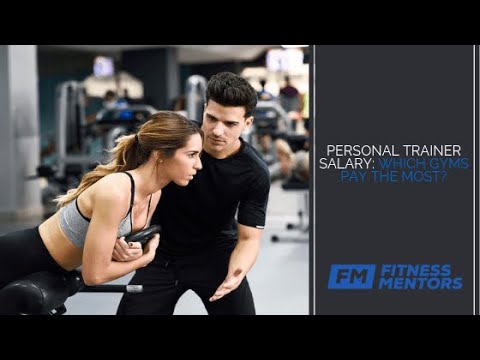
If you have a six-pack and an Olympic medal, you may think that jobs in a fitness facility are strictly reserved for athletes. However, not everyone needs a six-pack or a huge bank balance to be able to work in a gym. Read on to discover what each of these jobs entails. Find out which jobs you are eligible for. It's a great place to work.
Personal trainers
The benefits of hiring personal trainers in a gym are many. These experts will help you to master your workouts, overcome fears, and improve your overall health. Personal trainers make it easy to make the gym experience enjoyable for both you and your family. In gyms that offer group classes personal trainers may be available. This allows you to make new friends and make new connections while working out. You can rest assured that these instructors are qualified and experienced fitness experts.
An excellent personal trainer should also be in good physical condition. This is especially true for men. Women tend to have lower levels of physical fitness. Clients will not respect a personal trainer who isn't fit. A certified personal trainer course teaches you new exercises and correct form. Your clients will benefit from the knowledge gained. To make a living in personal training, you will need a marketing strategy.

Instructors for group exercise
Group exercise instructors need to be passionate about fitness and communicate well. Instructors must inspire others and feel comfortable working with people of all backgrounds. It is also recommended that group exercise instructors get certified through a nationally recognized organization. This certification is available through the National Exercise Trainers Association. This opens up many doors for group instructor. This certification could lead to better salaries and working conditions for future instructors. It can also lead to master instructor positions or even the opening of one's own gym.
To become a group exercise instructor, an individual must have the required skills and qualifications. They must hold a high school diploma. They must also have completed an approved exercise instructor course. This course is usually six weeks long and includes classroom instruction. The course will cover anatomy, fitness, and kinesiology. Instructors must also have a good understanding of nutrition.
Supervisors for facilities
Job Description: For management positions, facilities supervisors in gyms or fitness centres may require a bachelor's Degree. However, those with a high school diploma can also enter the industry. They need to be able manage conflict and solve problems. They typically earn $56,000 annually, although the average salary for facility supervisors is around $53,000.
This position also requires employees to maintain the gym's equipment and facilities. The gym supervisor oversees the ordering and maintenance of equipment as well creating a cleaning schedule. A friendly person with strong customer service skills and experience in group exercise is required for this job. The job also requires the ability to perform emergency medical procedures. These skills are a huge asset to any gym.

Front desk manager
The job of a front desk manager in a gym is to oversee the activities of front-end employees and customer interactions. The front desk team is responsible in ensuring that members are satisfied and reaching revenue targets. As well as performing administrative tasks, this position requires the manager to establish a great rapport with staff members and encourage teamwork. This position requires you to spend approximately 30 hours per week at the front desk. The rest of the time, however, is spent performing administrative tasks.
You may be required to work weekends for this position. Along with a regular work schedule, the Front Desk manager may be required to work weekends. This position is highly demanding as it requires you to multitask and work in a fast-paced environment. If you are looking for a challenging, fast-paced role, a front desk supervisor will be a great fit. Along with the above duties, the Front Desk Supervisor will also be responsible for overseeing a 12-person team.
FAQ
Can I exercise after eating?
It depends on what type of exercise you're performing. Avoid strenuous exercises after meals. It could cause stomach cramps. Focus instead on light aerobic exercises like biking or walking briskly.
Can I eat while I exercise?
Yes. While you're working out, you can eat whatever you'd like. Make sure you choose low-calorie snacks such as watermelon, carrots, celery, apples, bananas, and grapes. These foods provide nutrients that improve your performance during exercise.
What can exercise do for your body and mind?
Exercising helps you lose weight, build muscle mass, increase energy levels, reduce stress, and improve sleep quality. You will experience improved moods and self-esteem as well as increased productivity and a lower risk of developing heart disease.
Are there exercises I shouldn’t perform?
Before starting any new exercise program, you should consult your doctor. You may have injuries or other medical conditions that prohibit you from exercising in certain ways. You may also need special equipment or training for certain activities. For example, swimming requires a swimsuit and pool access.
What happens to me if I don’t sleep enough?
Insufficient sleep can cause your brain to not receive the signals necessary for hormone regulation and other chemicals involved in controlling appetite and metabolism. As a result, your body may become more hungry and can gain weight. Sleep deprivation can also lead to excessive weight gain.
Do I need food before I exercise?
No. You don't have to eat before you start working out. But if you're feeling hungry after exercising, you may be tempted to snack on light foods like yogurt or fruit.
Statistics
- Physical activity confers the following maternal and fetal health benefits: a decreased risk of pre-eclampsia, gestational hypertension, gestational diabetes (for example, 30% reduction in risk) (who.int)
- Adolescent girls were less active than adolescent boys, with 85% vs. 78% not meeting WHO recommendations of at least 60 minutes of moderate to vigorous intensity physical activity per day. (who.int)
- In high-income countries, 26% of men and 35% of women were insufficiently physically active, as compared to 12% of men and 24% of women in low-income countries. (who.int)
- Globally, 28% of adults aged 18 and over were not active enough in 2016 (men 23% and women 32%). (who.int)
External Links
How To
How To Burn Belly Fats Faster
Belly Fat is often thought of as a problem when trying to lose fat. If you look at it, belly fat is actually a positive thing. Your organs are protected from being damaged by excess belly fat. Let's now see how to quickly lose belly fat.
Lack of exercise and stress are the main reasons we store body fat. Because of its stimulation of the production hormone cortisol, stress can make us feel hungry continuously. Cortisol levels are increased by insulin. Insulin then stores excess calories as fat. An increased appetite can be caused by a lack of sleep. These extra calories can be broken down by exercising.
There are many options to reduce belly weight. All of these methods can be used, depending on your budget. These are some ways to quickly lose belly fat.
-
Try to eat less food. You should eat smaller meals throughout the day than you would if you ate three big meals. This will help you consume less calories.
-
Drink plenty of water. Water flushes out toxins, and keeps your body hydrated. Drinking water before meals will help you feel fuller for longer, so you don't overeat.
-
Avoid unhealthy snacks. If you're looking for quick fixes, snack foods like chips, cookies, candies, etc. These tempting snacks might look appealing. These sweet treats can be tempting, but they are high in empty calories and sugar. Instead, choose healthy alternatives like fruits, veggies, nuts, seeds, and whole grains.
-
Do strength training exercises at least three times per week. Strength training increases muscle mass, which can help you burn more calories while still resting. It strengthens bones and muscles, ligaments, muscles, tendons, heart, lungs, as well as joints.
-
Walking or stretching is a good habit to do regularly. Stretching helps to improve flexibility and mobility, which reduces back pain. Walking is a great way of burning calories, especially when you do it for just 30 minutes.
-
Reduce alcohol intake. Avoid alcohol.
-
Lose weight gradually. To lose weight, the first step is to determine what your current weight. Calculate your ideal weight by adding approximately 5% to 10% of the total weight. Once you have calculated your target body weight, you can begin to cut calories by 500-1000 calories every day until your goal is reached.
-
Avoid processed food. These foods are high in salt, sugar, preservatives, and other harmful ingredients. Processed foods are often very convenient but don't provide enough nutrients to keep you healthy.
-
Don't skip breakfast! Breakfast is good for your concentration, memory, and energy. Breakfast should include protein (like eggs), fiber (like oats), and complex carbohydrates (like oatmeal).
-
Have regular bowel movements. Gas and bloating can result from irregular bowel movements. Drink plenty of water to prevent gas and fiber ingestion.